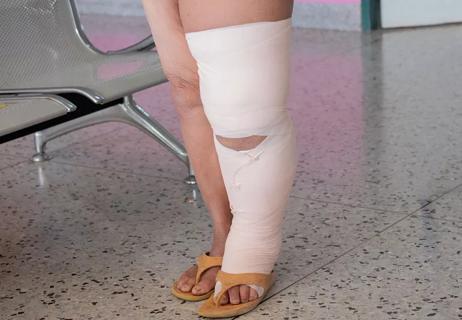Pain may signal a damaged nerve or herniated disk

If you experience a sharp, regular or recurring pain shooting or radiating down your leg — known as radiculopathy — you may suffer from a damaged nerve or a herniated disk in your spine.
Advertisement
Cleveland Clinic is a non-profit academic medical center. Advertising on our site helps support our mission. We do not endorse non-Cleveland Clinic products or services. Policy
When you feel that type of back or leg pain, contact your primary care doctor. They can estimate the level of damage — from mild to severe — and help you decide how to tackle the problem, says spine surgeon Dominic Pelle, MD.
There are typically four levels of treatment used to treat radiating pain in your leg. Depending on the severity of your pain, your doctor will recommend one or more of the following:
If over-the-counter anti-inflammatory medication such as ibuprofen doesn’t work, your next step will be to have an informal examination with your doctor.
“As long as you don’t show any signs of significant muscle weakness, you will usually be prescribed an anti-inflammatory medication or a steroid dose pack,” says Dr. Pelle.
If a nerve root is inflamed by a disk herniation or irritated by normal degeneration from aging, then the pain will often calm down.
If after several weeks, the pain is not improving, your doctor will initiate physical therapy to help strengthen and stretch the muscles supplied by the nerve. Doctors often recommend stretching exercises, back strengthening exercises, or a McKenzie back program for a suspected disk herniation.
These exercises may alleviate the symptoms over time. “In approximately 80% of patients with radiating leg pain, the pain will subside on its own without surgery,” says Dr. Pelle.
Advertisement
However, if the pain and other symptoms persist for more than six to eight weeks despite these measures, your doctor may order X-rays or an MRI (magnetic resonance imaging) and may refer you to an interventional pain specialist or a pain management specialist.
A lumbar X-ray and/or an MRI scan can often help reveal the cause of the problem. Scans may reveal a disk herniation causing nerve compression or nerve compression from age-related arthritic changes. This may cause spinal canal or foraminal narrowing called stenosis, which puts pressure on your spinal cord or nerves from the squeezed areas.
If the scans reveal one of these conditions, your pain management physician may consider treatment with a spinal injection.
These injections are steroid treatments targeted to the specific area of compression or inflammation to calm the nerve root, rather than an anti-inflammatory steroid. This process may only require one injection or might require additional injections.
If spinal injections provide some relief but it’s not long-lasting, a surgical evaluation will be the next step.
“At that point, we would examine the patient and review the imaging,” says Dr. Pelle. “Then we would discuss surgical options, including the risks and benefits, and most importantly, the anticipated outcome.”
Consult your doctor when you experience persistent pain radiating down your leg. It’s crucial to continue exercising and doing back strengthening exercises to keep your muscles active.
“Continue with your normal activities as you are able,” says Dr. Pelle. “If your muscles become unused, that will weaken the body’s structural support system for your spine and make recovery more difficult.”
Advertisement
Learn more about our editorial process.
Advertisement

Regular exercise, an iron-rich diet, adequate sleep and bedtime routines that include a warm bath or massage may help with your kid’s RLS

It could be your feet need a rest, but swollen legs may also be a sign of a serious condition

Strategies for getting the sleep you need

The short answer from an interventional cardiologist

The short answer from a sleep expert

Shake loose with these tips and home remedies

Here are some factors your doctor may consider

How to find relief

If you’re feeling short of breath, sleep can be tough — propping yourself up or sleeping on your side may help

If you fear the unknown or find yourself needing reassurance often, you may identify with this attachment style

If you’re looking to boost your gut health, it’s better to get fiber from whole foods